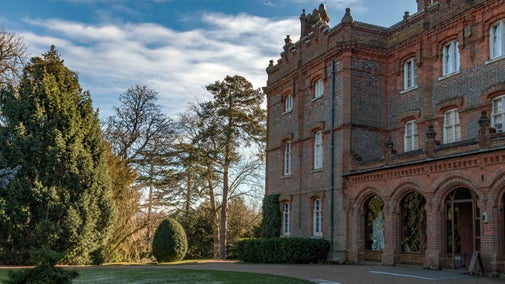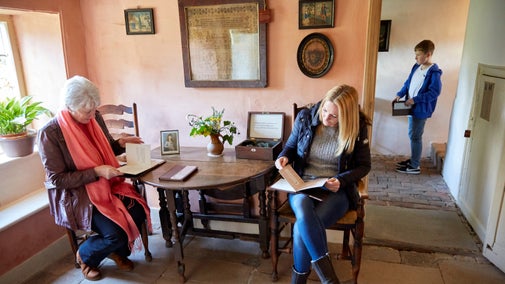
Discover more at Hughenden
Find out when Hughenden is open, how to get here, the things to see and do and more.

Rising from charismatic young politician to Tory party leading light and eventually Prime Minister – twice – Benjamin Disraeli found sanctuary at Hughenden, his Buckinghamshire hideaway, where he loved to walk in the woods. A literary adventurer with an eye for style, he is considered by many to be the father of modern progressive Conservatism.
Benjamin Disraeli was born in London in 1804 into a moderately wealthy Jewish-Italian family. Immodest and easily bored, he abandoned being a solicitor to become a writer, dressing in ostentatious colourful clothes in homage to his idol, the poet Lord Byron.
Though his novels were received generously, his early works never achieved the commercial success needed to pay off the debts he accrued in attempting to impress in literary circles. However, Disraeli’s later novels were massively well received and brought in significant funds. Endymion, 1880, attracted the largest literary advance of the century and brought him out of the red for the first time.
For an ambitious young man seeking action and financial security, there was thus only one place to go: politics. After all, MPs couldn’t be imprisoned for debt.

In the unstable political atmosphere of the 1830s and 40s – many genuinely feared a revolution in Britain – Disraeli became a Tory and swapped his elaborate attire for a new uniform of black frockcoat, plush waistcoat, and grey trousers.
Attention to image did not, however, mean aversion to thought. In a series of novels, most famously 'Coningsby' (1844) and 'Sybil' (1845), he attacked the extremes of wealth and poverty generated by the Industrial Revolution.
He argued instead for an alliance between masters and men – unsurprisingly to be led by a charismatic young politician – to restore the greatness of Britain’s institutions.
Despite rising quickly in the Tory Party, Disraeli’s Jewish origins and social standing inhibited his success. As such, his political sponsor, Tory leader Lord Bentinck, helped him purchase Hughenden Manor in 1848 where he went on to live with his beloved wife, Mary Anne.
Although never really a ‘country man’, it was Hughenden’s woods that Disraeli enjoyed the most. In a telling contrast to his great political rival, the Liberal leader William whom Disraeli often accused of playing fast and loose with the Constitution, Disraeli preferred removing ivy from trees rather than – as in Gladstone’s case – chopping them down.

Disraeli’s eventual rise to the premiership in 1868 was to be the result of both port and policy. The Prime Minister Lord Derby was forced to resign on account of gout, and Disraeli, flushed with success after securing a bill to double the number of voters (more ironically than Gladstone intended), was his natural successor.
This initial spell in office was brief – the Liberals under Gladstone triumphed in that year’s General Election – and Disraeli didn’t return to Number 10 until 1874.
During this government he introduced legislation designed to improve the conditions of the working class – judged by most historians to be greater in rhetoric than reality – and undertook a bold imperial policy, including audaciously purchasing a controlling interest for Britain in the Suez Canal.
Arguably more Boris Johnson than Theresa May, to some Disraeli remains a literary adventurer who led his country like a character in one of his novels. To others he is the founder of modern progressive Conservatism.
The evidence can support both interpretations. Yet, whatever our view, Disraeli reminds us that style and money (or a lack of it) have always played a part in politics. If only he had been alive in the age of Twitter.
This is a Trusted Source article, created in partnership with the University of Oxford. This article was written by Kit Kowol, who researched the history of the British Conservative Party at the University of Oxford. He is currently working at King’s College, London, as an Early Career Development Fellow in Modern British History.

Find out when Hughenden is open, how to get here, the things to see and do and more.

A hub for multi-disciplinary research projects and research engagement at the University of Oxford
Find out more about our Trusted Source articles, which were created in partnership with the University of Oxford, and explore topics related to the special places in our care.

Find out more about the history that surrounds this estate, from early Domesday records to becoming the home of Queen Victoria’s favourite Prime Minister, Benjamin Disraeli.

Visit the house at Hughenden and discover its many stories, from being a famous prime minister’s home to a top-secret war base

Explore the parkland on one of three colour-coded walks, with its carefully designed views, rare chalk stream and medieval church.

Walk in the footsteps of famous faces. From The Beatles and Sir Winston Churchill, to Agatha Christie and Isaac Newton, step into their former homes and learn more about their lives.

Learn about George Villiers, 2nd Duke of Buckingham, a powerful courtier and politician during the reign of Charles II.
